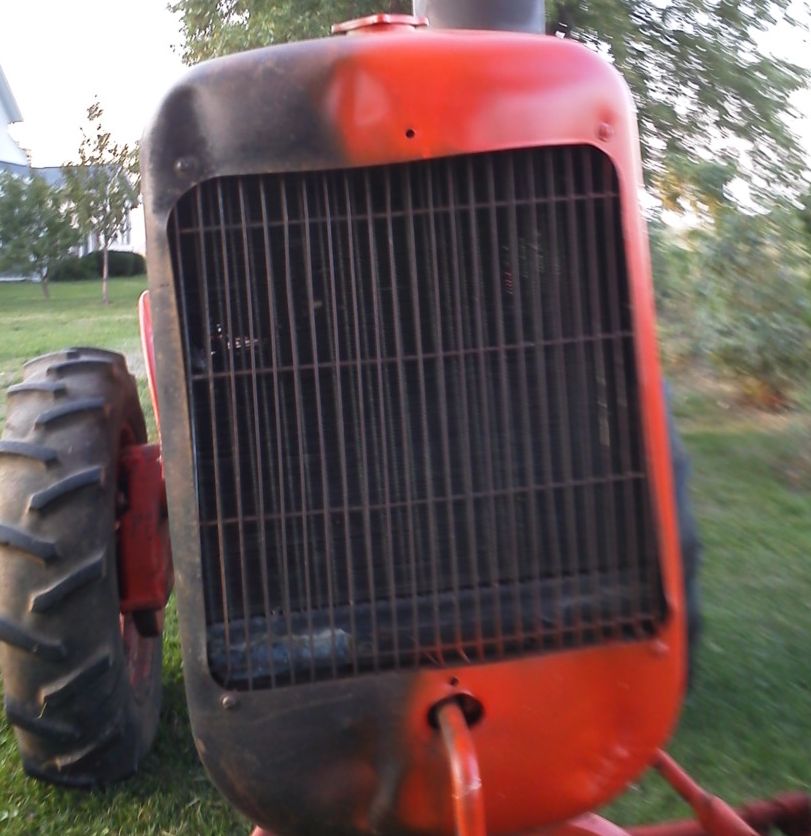| Author |
 Topic Search Topic Search  Topic Options Topic Options
|
desertjoe 
Orange Level Access


Joined: 23 Sep 2013
Location: New mexico
Points: 13729
|
 Post Options Post Options
 Thanks(0) Thanks(0)
 Quote Quote  Reply Reply
 Posted: 31 Jul 2024 at 8:00pm Posted: 31 Jul 2024 at 8:00pm |
Well, I have no idea what the reasoning was for the TWO resistors in the engine compartment,,,one of the persons on the Cushman Forum I been pestering did say the one of the resistors was for having full 12 volts while cranking and when engine started,,the resistor would cut back to lower voltage when full 12 volts not needed,,,,,??? How does the resistor KNOW when that happens,,,??
I used an old magnifying glass but the numbers on the porcelin are not clear enough to be sure,,,if there is a dot between the 6 and the 0,,,I cannot see it,,and I agree that it is most likely 6.0 instead of 60,,,,,  
Edited by desertjoe - 31 Jul 2024 at 8:04pm
|
 |
|
Sponsored Links
|
|
 |
steve(ill) 
Orange Level Access


Joined: 11 Sep 2009
Location: illinois
Points: 88509
|
 Post Options Post Options
 Thanks(0) Thanks(0)
 Quote Quote  Reply Reply
 Posted: 31 Jul 2024 at 9:30pm Posted: 31 Jul 2024 at 9:30pm |
Joe.... all i know is on OLD CARS , they use to use the resistor in line from the battery to the coil to cut the voltage to keep it maybe 6-8 volts when running... When you turned the key to CRANK the motor, there was a BYPASS wire that put the 12v directly to the coil for STARTING..
On old tractors that have been converted to 12v, the use the resistor to cut the coil voltage to 6 volts ALL THE TIME... start or run... I think a 6 volt coil is about 1.5 ohms and a 12 volt coil is 3 ohms...... not sure where the 6 or 60 comes from ???
|
|
Like them all, but love the "B"s.
|
 |
steve(ill) 
Orange Level Access


Joined: 11 Sep 2009
Location: illinois
Points: 88509
|
 Post Options Post Options
 Thanks(0) Thanks(0)
 Quote Quote  Reply Reply
 Posted: 31 Jul 2024 at 9:32pm Posted: 31 Jul 2024 at 9:32pm |
|
You might look at the wire layout and see what the RESISTOR is doing... Does it reduce the VOLTATE to the COIL during START.. or does it cut the Voltage all the time ? You might be able to BYPASS the resistor ( jumper both sides together) and see if you get a GOOD SPARK with the higher voltage..
|
|
Like them all, but love the "B"s.
|
 |
desertjoe 
Orange Level Access


Joined: 23 Sep 2013
Location: New mexico
Points: 13729
|
 Post Options Post Options
 Thanks(0) Thanks(0)
 Quote Quote  Reply Reply
 Posted: 01 Aug 2024 at 9:07pm Posted: 01 Aug 2024 at 9:07pm |
According to one of the members of a Forum I been bothering that did venture of a wire at the key that does drop the voltage to the coils when key is turned to start,,then drops out when engine starts,,,? As with purists of every group,,,,he strongly cautioned me to replace the bad resistor with a new one post haste,,,,but,,I also received several suggestions to remove or bypass both resistors for better spark quality and better performing engine,,,,???
BUT,,,,BUT,,,,the best news of the day is,,,,,,(lets have a drum roll, DIYDAVE,,   These OMC 2 cylinder engines have a highly questionable intake piping that includes a rubber " T " that on most Cushmans have deteriated over the years by developing cracks in the rubber almost big enough to poke your finger in the cracks. (Please no dirty comments here) Mine was that way, so I been fashioning a replacement from a 1" copper tubing T that is almost a direct fit to the intake piping ,,but did take many Installs and removals to get it just right so nothing leaks......   AND FIRED THAT MOTHER UP,,,!!!!   Engine runs many wonderfuls and sounds great with NO smoke out the exhaust,,,except the dang KEIHIN carburator kept leaking at one of the bolt holes,,? I had opened it up and it was very clean but will pull it tamarrow to check it out and reset the float level.,,,,,, ps,,,I bypassed both resistors, Steve)  
|
 |
steve(ill) 
Orange Level Access


Joined: 11 Sep 2009
Location: illinois
Points: 88509
|
 Post Options Post Options
 Thanks(0) Thanks(0)
 Quote Quote  Reply Reply
 Posted: 01 Aug 2024 at 9:54pm Posted: 01 Aug 2024 at 9:54pm |
|
bypassing the resistors lets the FULL 12v go to the coil and point ( or ingnition box).... normally that is not a BIG DEAL... but could cause premature wear / failure of those parts... I am not familiar with that SPECIFIC engine.. If "MANY" have said you can bypass and not have a long term problem, that sounds like a good move !!
|
|
Like them all, but love the "B"s.
|
 |
DaveKamp 
Orange Level Access


Joined: 12 Apr 2010
Location: LeClaire, Ia
Points: 6089
|
 Post Options Post Options
 Thanks(0) Thanks(0)
 Quote Quote  Reply Reply
 Posted: 04 Aug 2024 at 10:38am Posted: 04 Aug 2024 at 10:38am |
If the coils are original, they're most likely wound to fire at either 4.5v, or 9v. They'll run at 6v or 12v (respectively) and at 7.3v or 14.4v (when charging), however, they will flow considerably more current doing so. When used in an 8 or 6 cylinder engine, these coils will operate and survive simply because the more frequent ignition events reduce the coil's total 'dwell time' over a course of an engine rotation, than in a single-cylinder application.
They'll work without ballast resistance, but usually, within a dozen hours of operation or so, they'll overheat and expire. They'll frequently, but not always burn up contact points... if they're good quality plated points, they'll tough it out.
The other aspect of smaller engine coil design, is vibration. Small, lightweight air cooled motors with few cylinders shake the bejesus out of components... that's why Kohler K-singles don't last long with an ordinary store-shelf ignition coil, and that's why they wear out strange things like carbeurator float pivots.
Modern electronic ignition solves the dwell-time circumstance by doing all the 'hard' work electronically, and only flowing coil current when necessary.
Lots of marininized setups use a 'resistance wire' rather than a resistor module. Imagine about 8 feet of flameproof cloth wrapped nichrome wire included in the wiring harness of a boat engine... that's what many did. nichrome is significantly less willing to carry current than standard copper wire, so they used it instead. There's still a bypass lead coming from the starter solenoid, so that the coil gets full battery on crank, but release the key and coil current flows through the nichrome.
The giveaway that a coil resistor has failed, is the 'starts but won't run'... as you're cranking, it fires, but as soon as you release the key, it looses spark.
The converse circumstance (poor starting, or no start) is often a weak cranking spark, from the bypass circuit not being operational... it's trying to crank and fire limited spark whilst doing so.
|
|
Ten Amendments, Ten Commandments, and one Golden Rule solve most every problem. Citrus hand-cleaner with Pumice does the rest.
|
 |
desertjoe 
Orange Level Access


Joined: 23 Sep 2013
Location: New mexico
Points: 13729
|
 Post Options Post Options
 Thanks(0) Thanks(0)
 Quote Quote  Reply Reply
 Posted: 04 Aug 2024 at 10:23pm Posted: 04 Aug 2024 at 10:23pm |
Hey Dave Kamp,,,,,So, what range of resistor(s) do you think should be in this service,?? There were two resistors that were different from each other bolted on next to the two coils but since the PO was not too terribly judicious about taking care of the engine neither resistor was hooked up to any thing,,,no wires ,,nothing. On one of the forums I been visiting,,one of the members did mention a resistor of 60 ohms. I cleaned the one resistor and it was a 60 ohm,, but then ole Jay questioned if the resistor might be a 6.0 ohm,,, The other resistor did NOT have any writing on it. I did get the engine running by deleting the resistors and the engine started and did run but I did not let it run longer that 5 minutes for fear of burning up the new points and condenser,,,!! What do you think??
|
 |
Les Kerf 
Orange Level

Joined: 08 May 2020
Location: Idaho
Points: 1384
|
 Post Options Post Options
 Thanks(0) Thanks(0)
 Quote Quote  Reply Reply
 Posted: 04 Aug 2024 at 10:45pm Posted: 04 Aug 2024 at 10:45pm |
|
I don't think a 60 ohm resistor will allow enough current flow (amps) to make reliable ignition; 6 ohms would be plenty. Time to get out the ohmmeter
|
 |
DMiller 
Orange Level Access

Joined: 14 Sep 2009
Location: Hermann, Mo
Points: 34340
|
 Post Options Post Options
 Thanks(0) Thanks(0)
 Quote Quote  Reply Reply
 Posted: 05 Aug 2024 at 6:12am Posted: 05 Aug 2024 at 6:12am |
|
Old Style Ballast Resistors had minimal resistance until sent power thru them, Heat from electrical Induction of a coil caused resistance to flare every time current passed thru. That is why worked so well. Try to find a old series Ceramic, coiled wire ignition ballast.
|
 |
jaybmiller 
Orange Level Access

Joined: 12 Sep 2009
Location: Greensville,Ont
Points: 24776
|
 Post Options Post Options
 Thanks(0) Thanks(0)
 Quote Quote  Reply Reply
 Posted: 05 Aug 2024 at 7:17am Posted: 05 Aug 2024 at 7:17am |
Hay DJ Please measure the resistance of the coils. It'll probably be low, less than 10 ohms.....
'Points' typically like less than 4 amps through them ,else they pit and burn up.
Once we know the coil ohms, can figure out the resistors you should have ( or at least 'safe' ones ). BTW the ones in purdy colored finned aluminum are much better that the old ceramic logs.
|
|
3 D-14s,A-C forklift, B-112
Kubota BX23S lil' TOOT( The Other Orange Tractor)
Never burn your bridges, unless you can walk on water
|
 |
DaveKamp 
Orange Level Access


Joined: 12 Apr 2010
Location: LeClaire, Ia
Points: 6089
|
 Post Options Post Options
 Thanks(0) Thanks(0)
 Quote Quote  Reply Reply
 Posted: 05 Aug 2024 at 7:44am Posted: 05 Aug 2024 at 7:44am |
The formula for current flow through a resistor is:
I = P/R
where
I = Current P = Potential in Volts R = Resistance in Ohms
So if you were to connect a resistor directly across a 12v battery:
12/60 = 0.2A.
IF you connected a coil across that circuit, it would need to be able to fire at 0.2A... and that's not anywhere CLOSE to what an ignition coil will draw.
A typical 8-cyl 12v automotive ignition coil 's primary winding will be around 1.5-2.5 ohms... if it were run on straight 12v, that would put it around 5-8 amperes with no ballast resistor... but at 14.6v, that would be 6-9.75amperes. Cold Cranking, though, pulls the system/battery voltage down to about 9v... which means there's only 3.6 to 6A at the coil.
A typical 4-6 cyl automotive ignition coil's primary will be somewhere 2.5-4 ohms... that'd be 2.5-3 amperes... with no resistor. At fully charging 14.6, that'd yield 3.6 to 5.8 amperes, and down at 9v, that's 2.25 to 3.6v.
These coils MUST be able to sling a hot spark when cranking at 9v... but when the engine is running, and charging system is up above 14, they need to be limited somehow to keep from being burned up.
The difference between cold-cranking and running-warm-charging can be significant... going from 9 to 14.6v is a 160% change.
So to get the reliable starting under cold cranking, the coil is wound to fire well around 9V, and the ballast resistor limits current so it'll be reliable up to 14.6 or so.
Typically, the resistor will EXHIBIT the same general range as the coil's primary. a 3 ohm coil would be protecting a 3 ohm coil... as that would cut the operating current in half.
As Dmiller noted- ceramic ballast resistors tend to 'drift' with temperature. Like the 'resistance wire' I described earlier, a ceramic ballast resistor doesn't use carbon film or other types of materials that a precision electroncis resistor uses... instead, they use a ceramic coated nichrome wire element, that changes resistance as it warms up. Let's say you test a 3-0hm ballast resistor... At -30F, it may be 2.5 ohms, but running on a hot day, the shell might be 180F, it'll be almost 4 ohms.
60 ohms is out of reach for that application. You probably have a 60 ohm resistor there, but it was either put there in error, or it was supposed to be for some OTHER purpose (like powering a temperature gauge, fuel level, or oil pressure circuit).
|
|
Ten Amendments, Ten Commandments, and one Golden Rule solve most every problem. Citrus hand-cleaner with Pumice does the rest.
|
 |
desertjoe 
Orange Level Access


Joined: 23 Sep 2013
Location: New mexico
Points: 13729
|
 Post Options Post Options
 Thanks(0) Thanks(0)
 Quote Quote  Reply Reply
 Posted: 08 Aug 2024 at 6:57am Posted: 08 Aug 2024 at 6:57am |
60 ohms is out of reach for that application. You probably have a 60
ohm resistor there, but it was either put there in error, or it was
supposed to be for some OTHER purpose (like powering a temperature
gauge, fuel level, or oil pressure circuit).
BINGO,,,,!!! Hey Dave Kamp,,,Me thinks that is exactly what has happened here,,,whether the PO thought the previous resistor was bad or whatever,,and just installed one from who knows where is very likely,,,prolly what I would of done in a pinch,,,SO, maybe the resistor that is in there now (bypassed) is prolly a 6.0 instead of a 60,,,,???
|
 |
DaveKamp 
Orange Level Access


Joined: 12 Apr 2010
Location: LeClaire, Ia
Points: 6089
|
 Post Options Post Options
 Thanks(0) Thanks(0)
 Quote Quote  Reply Reply
 Posted: 10 Aug 2024 at 1:23am Posted: 10 Aug 2024 at 1:23am |
|
Possibly!
|
|
Ten Amendments, Ten Commandments, and one Golden Rule solve most every problem. Citrus hand-cleaner with Pumice does the rest.
|
 |
Thad in AR. 
Orange Level Access


Joined: 12 Sep 2009
Location: Arkansas
Points: 9668
|
 Post Options Post Options
 Thanks(0) Thanks(0)
 Quote Quote  Reply Reply
 Posted: 16 Aug 2024 at 5:24am Posted: 16 Aug 2024 at 5:24am |
|
How’s the Cushman project for your friend coming along?
|
 |
jaybmiller 
Orange Level Access

Joined: 12 Sep 2009
Location: Greensville,Ont
Points: 24776
|
 Post Options Post Options
 Thanks(0) Thanks(0)
 Quote Quote  Reply Reply
 Posted: 16 Aug 2024 at 5:53am Posted: 16 Aug 2024 at 5:53am |
|
he's busy installing his new 'puter into it !!!!
|
|
3 D-14s,A-C forklift, B-112
Kubota BX23S lil' TOOT( The Other Orange Tractor)
Never burn your bridges, unless you can walk on water
|
 |
Thad in AR. 
Orange Level Access


Joined: 12 Sep 2009
Location: Arkansas
Points: 9668
|
 Post Options Post Options
 Thanks(0) Thanks(0)
 Quote Quote  Reply Reply
 Posted: 16 Aug 2024 at 3:12pm Posted: 16 Aug 2024 at 3:12pm |
|
He sure must be a good friend if ole Joe’s restoring a Cushman for him.
|
 |









 Topic Options
Topic Options


 Post Options
Post Options Thanks(0)
Thanks(0)







